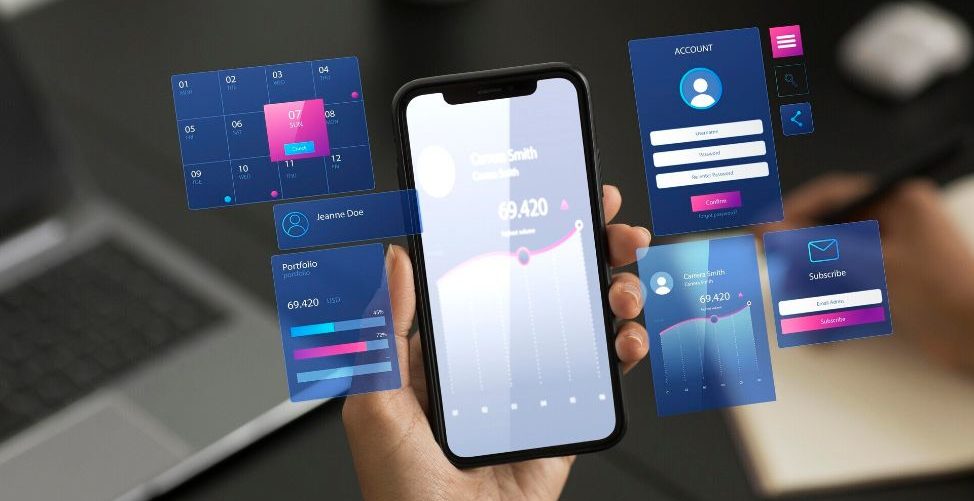October 06, 2021
Blockchain Application Development: A Comprehensive Guide in Australia
The blockchain tech market, pegged at $10.2 billion in 2022, is on track for exponential growth with an expected CAGR of 87.7% from 2023 to 2030. This impressive surge underscores the increasing adoption and transformative potential of blockchain application development across various industries worldwide.
Unlike traditional app development, blockchain introduces a whole new playbook of features and challenges, making it a real game-changer in the tech world. Now, here we go to dig deeper into this fascinating and expansive field.

What is Blockchain Application Development?
Blockchain application development refers to the process of designing and building applications that run on blockchain infrastructure. These applications may take the form of decentralized apps (dApps) operating on public blockchains, or enterprise-grade solutions deployed on private or permissioned networks. Unlike traditional apps that rely on centralized servers, blockchain-based apps leverage distributed networks to ensure transparency, security, and resistance to tampering.
At its core, blockchain application development is shaped by four key principles:
- Decentralization: Control and data are distributed across a network of participants, eliminating single points of failure.
- Immutability: Once data is recorded on the blockchain, it cannot be altered—ensuring auditability and trust.
- Smart Contracts: Self-executing code stored on the blockchain automates business logic and transactions.
- Distributed Consensus: Transactions are validated by multiple nodes, ensuring integrity and reliability without centralized approval.
These principles enable blockchain apps to deliver enhanced security, transparency, and automation across a wide range of use cases.
Why Blockchain App Development Is Growing in Australia
Australia is emerging as a leading adopter of blockchain technology, driven by a combination of forward-thinking policy, sector demand, and digital innovation. As organizations look to future-proof their operations, blockchain application development is becoming increasingly relevant across both public and private sectors.
- Government Support and Regulatory Initiatives: The Australian government has actively promoted blockchain adoption through initiatives such as the National Blockchain Roadmap, Digital ID pilots, and support for New Payments Platform (NPP) innovation. These frameworks create a regulatory environment that encourages experimentation while focusing on consumer protection, compliance, and interoperability.
- Rising Demand for Transparency and Auditability: Industries like supply chain, healthcare, and financial services are under growing pressure to offer end-to-end transparency and traceability. Blockchain’s immutable recordkeeping and audit trails make it ideal for applications like provenance tracking, clinical data sharing, and real-time payment reconciliation.
- The Fintech Boom and Blockchain’s Role in Web3 Innovation: Australia’s fintech ecosystem continues to expand, with startups and challenger banks exploring DeFi, tokenization, and digital assets as part of broader Web3 innovation. Blockchain apps are driving the next generation of financial infrastructure—from decentralized exchanges to smart contract-based lending platforms.
- Demand for Secure, Tamper-Proof Digital Ecosystems: Across public services and government agencies, there’s a growing focus on digital trust. Blockchain’s decentralized and tamper-proof architecture makes it ideal for use cases like e-voting, digital identity verification, and land title management, where data integrity is critical.
With strong market drivers and a supportive regulatory climate, Australia is well-positioned to lead in blockchain application development—transforming everything from banking to public infrastructure through secure, transparent, and scalable digital solutions.
Key Steps for Blockchain Application Development
Here’s a rundown of the essential steps to develop a successful blockchain application:
Analyze the Market
Blockchain technology is making waves across various industries, each with its own set of challenges and opportunities. Grasping the market landscape is vital before starting on blockchain application development. Here’s how blockchain is applied in different sectors:
- Banking and finance: Blockchain is shaking up financial transactions with enhanced security, transparency, and efficiency.
- Insurance: Blockchain boosts transparency and slashes costs in insurance processes.
- Healthcare: Blockchain ensures data security and interoperability in healthcare, enabling the secure exchange of sensitive patient information among healthcare providers.
- Real Estate: Blockchain simplifies property transactions by providing a secure, transparent ledger for tracking ownership and transfers of real estate assets.
- Retail: Blockchain guarantees product authenticity and supply chain transparency, reducing counterfeit goods and building trust between consumers and retailers.
- Supply Chain: Blockchain enables end-to-end traceability of goods, improving supply chain efficiency and cutting down on fraud in sectors like agriculture, transportation, and logistics.
- Gaming: Blockchain introduces new monetization models and enhances digital asset ownership in gaming, with platforms like Ethereum enabling decentralized gaming applications.
Read more: Why is Infrastructure Blockchain Essential for Australian Companies?
Generate an Idea
Creating a blockchain app starts with identifying a real-world problem that blockchain can effectively solve. Here’s how to get started:
- Identify a problem: Look for inefficiencies, lack of transparency, high transaction costs, or security issues in existing systems within your target industry.
- Draft business requirements: Define clear objectives and functionalities for your blockchain app. What’s more, outline user needs, regulatory requirements, and technical specifications.
By clearly defining the problem and drafting detailed business requirements, you lay a solid foundation for your blockchain application.
Conduct Competitor Research
Competitor research is crucial for understanding market trends, identifying gaps, and refining your blockchain app idea. Here’s how to do it:
- Identify competitors: Research companies already offering blockchain solutions in your target industry.
- Analyze offerings: Study their features, user experience, pricing models, and market positioning.
- Identify strengths and weaknesses: Determine what competitors do well and where they fall short. Use this information to differentiate your blockchain app.
Choose a Platform for Your Blockchain Project
Selecting the right blockchain platform is crucial as it determines your application’s capabilities, scalability, and suitability. Here are some key platforms to consider:
- Ethereum: Known for its robust ecosystem of decentralized applications (dApps) and smart contracts. It’s widely used for creating tokens (ERC-20, ERC-721) and decentralized finance (DeFi) applications.
- Hyperledger: An open-source collaborative effort offering enterprise-focused blockchain frameworks like Hyperledger Fabric and Hyperledger Besu, ideal for privacy, permissioned blockchains, and interoperability.
- R3 Corda: Designed for businesses, Corda facilitates direct transactions between parties while preserving privacy and confidentiality. It’s used in financial services for trade finance, insurance, and capital markets.
- Ripple: RippleNet is a global payments network built on the Ripple blockchain protocol, facilitating fast and low-cost cross-border payments and enabling real-time gross settlement systems.
Choosing the right platform depends on factors such as your project’s scalability needs, desired consensus mechanism, regulatory requirements, and development expertise.
Design Your Blockchain App
Designing your blockchain app involves creating a comprehensive architecture and user interface. Here’s how to approach it:
- Architecture design: Define the system architecture, including blockchain nodes, consensus mechanisms, and data storage protocols.
- UI/UX design: Design a user-friendly interface that simplifies interaction with blockchain features. Focus on usability, data visualization, and secure user authentication.
Develop and Test
Development and testing are critical phases in blockchain application development. Here’s how to tackle these stages:
- Develop with secure code: Implement blockchain protocols, smart contracts, and application logic using secure coding practices.
- Testing: Conduct rigorous testing, including functional, security, and performance testing. Ensure compliance with industry standards and regulatory requirements.
Maintenance and Support
Ongoing maintenance and support are essential for the sustainability of your blockchain app. Here’s how to approach it:
- Update and enhance: Regularly update blockchain protocols, smart contracts, and application features to address security vulnerabilities and improve functionality.
- User support: Provide technical support and training to users. Monitor system performance and address issues promptly to maintain operational continuity.
Marketing and Promotion
Launching your blockchain app successfully requires effective marketing and promotion strategies:
- Content marketing: Create informative content about blockchain technology and your app’s features. Publish articles, blogs, and case studies to educate your target audience.
- Social media marketing: Engage with potential users on social media platforms. Share updates, customer testimonials, and industry insights to build credibility.
- Partnerships and collaborations: Collaborate with industry influencers, blockchain communities, and strategic partners to expand your app’s reach and credibility.
Watch more: Top Strategies for Web3 Development in Australian Businesses
Why SmartOSC Is a Trusted Blockchain App Development Partner in Australia
When it comes to building secure, scalable, and future-ready blockchain applications, SmartOSC is a trusted partner for Australian businesses seeking real-world impact. With deep technical expertise and a strong regional presence, SmartOSC has delivered successful blockchain solutions across Ethereum, Hyperledger Fabric, and Layer 2 ecosystems, adapting to the specific needs of public, private, and consortium-based networks.
SmartOSC’s blockchain work spans key industries—including fintech, logistics, public sector, and digital identity—where transparency, automation, and compliance are mission-critical. From decentralized finance platforms and traceable supply chain systems to smart contract-based digital identity frameworks, the company has a proven track record in transforming concepts into production-grade applications.
What sets SmartOSC apart is its full-cycle development model: from early-stage blockchain strategy and use case validation, through UI/UX design, smart contract engineering, API integration, and performance optimization. This holistic approach ensures alignment with both business goals and technical standards from day one.
Crucially, SmartOSC places a strong application development emphasis on Australian compliance, including AML/CTF obligations, data protection laws, and financial licensing frameworks—ensuring blockchain applications are built for both innovation and regulatory confidence.
Trusted by clients across the APAC region, SmartOSC helps Australian organizations navigate the complexities of blockchain development and unlock the full potential of decentralized technology.
Conclusion
To sum it up, blockchain technology has become a game-changer across numerous industries, delivering unparalleled security, transparency, and efficiency in digital transactions.
Throughout this detailed guide, we’ve delved into the process of blockchain application development, which involves navigating a series of steps, from market analysis and ideation to platform selection, design, development, and deployment. Each stage demands careful planning, the right technological tools, and tackling challenges such as regulatory compliance, security threats, and interoperability issues. If this all seems a bit overwhelming, no worries! The pros at SmartOSC are ready to help. Reach out to us now to learn more about our solutions and how we can assist you in tapping into the potential of blockchain.
Related blogs
Learn something new today


